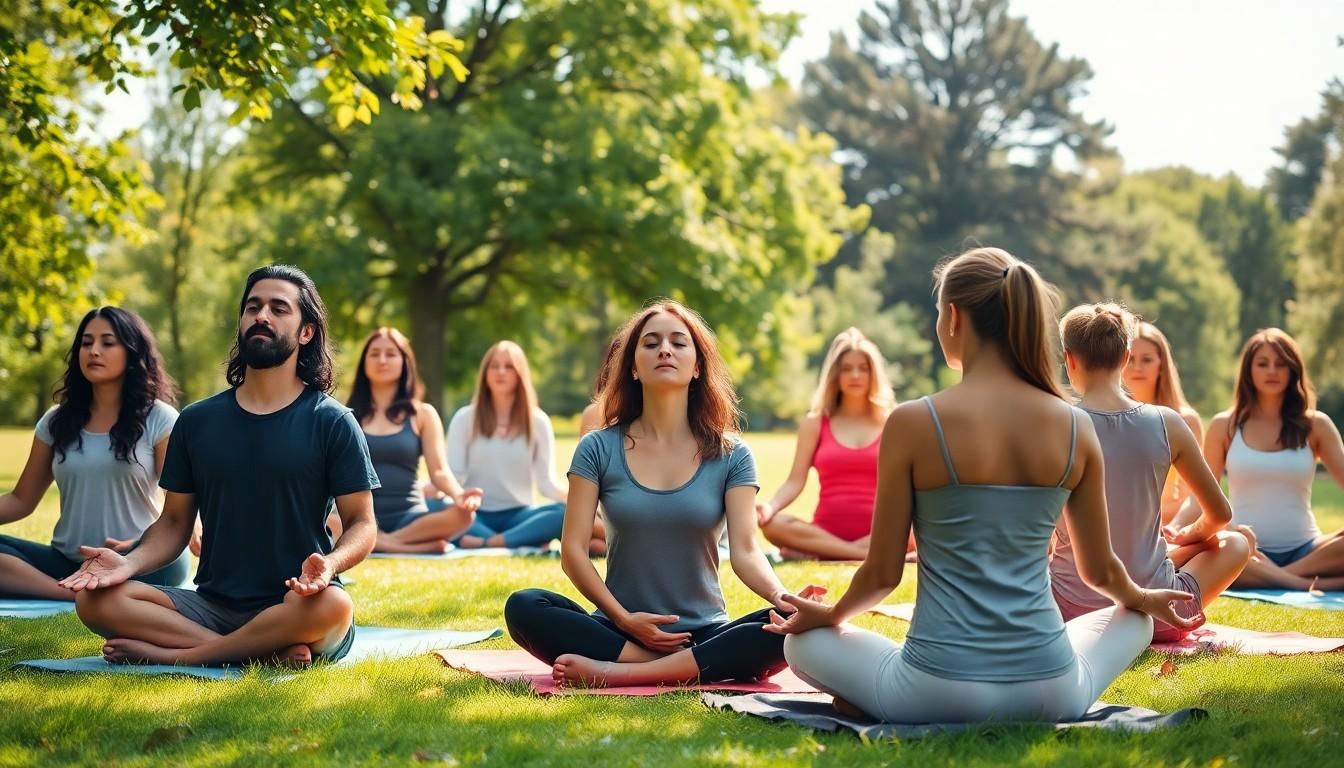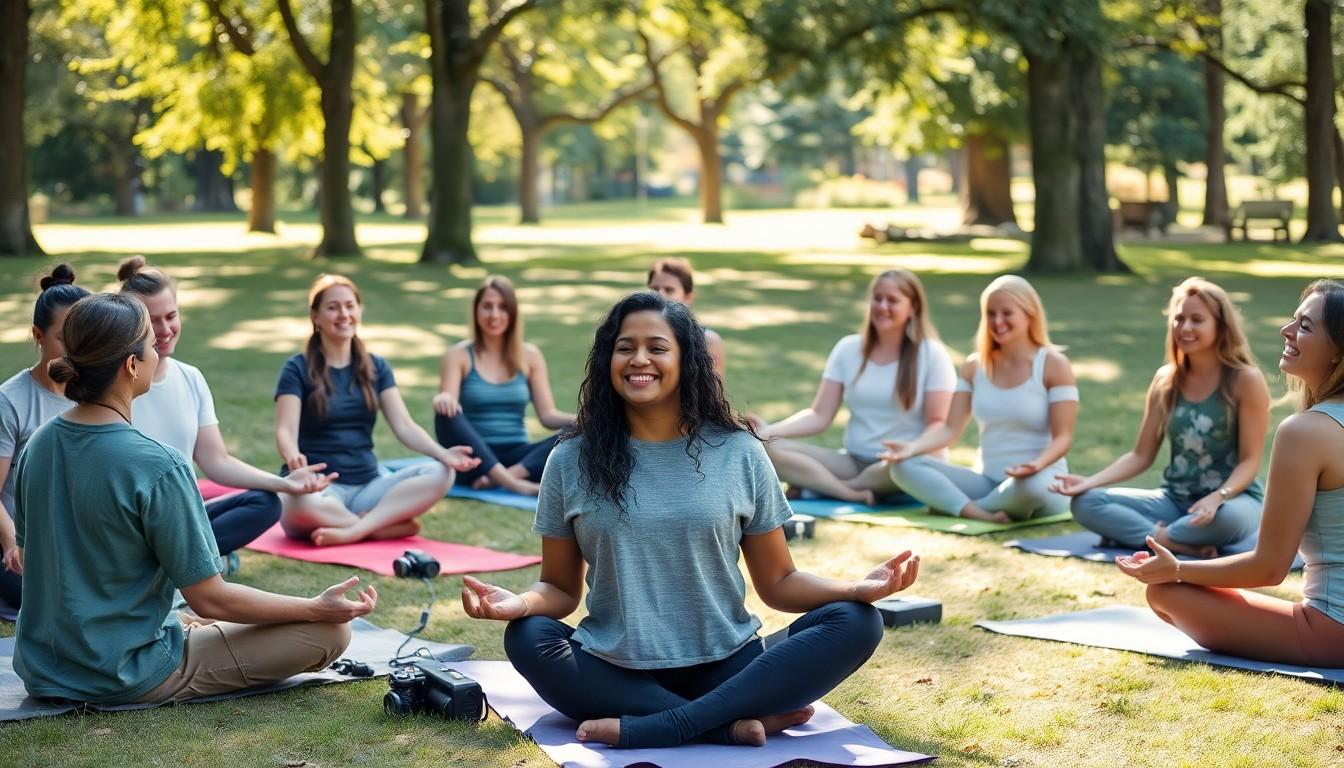In a world buzzing with distractions, finding calm can feel like searching for a needle in a haystack. Enter group mindfulness exercises—your ticket to tranquility and a dash of camaraderie. Picture this: a circle of friends, colleagues, or even strangers, all trying to channel their inner Zen while stifling giggles. It’s like yoga, but with more laughter and less chance of falling over.
Group mindfulness isn’t just about sitting cross-legged and humming. It’s a fun, engaging way to boost focus, reduce stress, and strengthen connections. Whether it’s through guided meditations or playful breathing techniques, these exercises transform the serious business of mindfulness into a delightful group activity. So grab a buddy or two, and dive into the world of mindfulness together. Who knows? You might just discover that serenity is best enjoyed with a side of laughter.
Overview of Group Mindfulness Exercises
Group mindfulness exercises comprise various activities designed to promote awareness and relaxation among participants. These sessions often include guided meditations, where an instructor leads the group through a series of calming activities. Breathing techniques play a crucial role, encouraging deep and intentional breaths that facilitate inner peace.
Participants often enjoy playful exercises that combine movement with mindfulness. Engaging in stretching or gentle yoga can heighten participants’ sense of presence. Each activity fosters a sense of community, allowing individuals to connect on a deeper level with one another.
Additionally, these exercises benefit mental health by reducing stress and enhancing focus. Scientific studies indicate that group participation can lead to heightened emotional regulation and resilience. Engaging with others allows for shared experiences, which can amplify feelings of connection and support.
Mindfulness circles serve as a safe space for each participant, promoting open expression and shared intentions. Regular practice within groups can reinforce commitment to mindfulness, benefiting both the individual and the collective. Group exercises enable participants to laugh and share lightness while cultivating serenity, demonstrating that mindfulness can take a more joyful approach.
As participants share their journey, they often feel encouraged to maintain their mindfulness practice. Group mindfulness not only enhances personal well-being but also strengthens relationships among participants. Collectively, these exercises transform a simple practice into an enriching communal experience.
Benefits of Group Mindfulness Exercises

Group mindfulness exercises offer significant advantages for participants. These activities not only promote relaxation but also enhance emotional and social well-being.
Enhanced Emotional Well-Being
Participating in group mindfulness exercises boosts overall emotional health. Scientific studies show that engaging in collective mindfulness practices reduces stress levels and enhances focus. Increased emotional regulation often results from shared experiences, fostering resilience among participants. As individuals practice mindfulness together, they cultivate a deeper understanding of their emotions. The communal aspect encourages open expression, which furthers personal growth and empathy. Group mindfulness exercises also create an environment that diminishes feelings of isolation. Through shared intentions, participants reinforce their commitment to emotional well-being.
Improved Social Connections
Group mindfulness activities significantly improve social connections among participants. These exercises naturally foster camaraderie and build trust within the group. Engaging in mindfulness together encourages participants to share their experiences and challenges. This sense of belonging enhances interpersonal relationships. As participants navigate mindfulness techniques collectively, they develop a supportive network. Effective communication emerges from these shared practices, leading to stronger bonds. Participants often report feeling more connected to one another after engaging in these activities. Additionally, the laughter and joy experienced during exercises create memorable moments that strengthen relationships further.
Types of Group Mindfulness Exercises
Group mindfulness exercises consist of various activities that promote awareness and relaxation among participants. Engaging in these exercises encourages connection and fosters a supportive environment.
Guided Meditation Sessions
Guided meditation sessions offer a structured approach to mindfulness. An instructor leads participants through a meditation practice, providing directions that enhance focus and relaxation. Such sessions often incorporate visualization and deep breathing techniques, allowing individuals to explore their thoughts and feelings in a safe space. Studies indicate that these sessions improve emotional regulation, communal understanding, and overall well-being.
Mindful Movement Practices
Mindful movement practices blend physical activity with mindfulness principles. Activities such as yoga and tai chi emphasize conscious breathing and body awareness, allowing participants to tune into their movements. Each practice enriches the group’s sense of presence and encourages stress reduction. Engaging in mindful movements fosters a sense of community while promoting physical health, ultimately enhancing participants’ emotional resilience.
Implementing Group Mindfulness Exercises
Implementing group mindfulness exercises requires thoughtful planning and execution. Creating an engaging atmosphere enhances participants’ experiences, leading to deeper connections and better outcomes.
Creating a Supportive Environment
A supportive environment encourages openness. Participants thrive in spaces that feel safe and welcoming, permitting them to express thoughts and emotions freely. Utilizing comfortable seating arrangements and soft lighting can foster relaxation. Facilitating an introductory circle helps participants connect before exercises begin. Establishing ground rules for respect and confidentiality allows for trusting interactions. Providing props like cushions or blankets can enhance comfort during longer sessions.
Choosing the Right Techniques
Choosing the right techniques hinges on participants’ needs and preferences. A variety of options ensures engagement among diverse groups. Guided meditations excel at cultivating focus and relaxation, particularly for beginners. Mindful movement practices, including yoga and tai chi, cater to those seeking physical activity intertwined with mindfulness. Incorporating playful breathing exercises invites laughter and light-heartedness into sessions. Experimenting with different activities during sessions can help identify what resonates most with the group. Prioritizing inclusivity fosters participation and enhances overall experience.
Challenges in Group Settings
Navigating challenges in group settings often arises during mindfulness exercises. Group dynamics can create distractions, impacting focus and engagement levels. Participants might feel hesitant to share personal thoughts due to fear of judgment, which inhibits open expression.
Finding a common ground among diverse participants presents another challenge. Variability in previous mindfulness experience impacts how individuals engage with exercises. Newcomers may struggle with techniques that more experienced members find easy, creating feelings of inadequacy.
Balancing varied comfort levels becomes essential. Some participants might prefer silence, while others may seek verbal encouragement. Adjusting exercises to accommodate these preferences requires thoughtful facilitation to ensure a supportive environment.
Time constraints can limit the effectiveness of mindfulness sessions. Shorter exercises may not provide sufficient depth for meaningful experiences. Facilitators should plan sessions that allow ample time for connection and reflection.
Occasionally, external factors such as noise or interruptions disrupt the flow. Managing the environment to minimize distractions helps maintain participants’ focus. Incorporating elements like soft music or appropriate seating arrangements can enhance overall experience.
Lastly, potential resistance to mindfulness practices exists among some participants. Some may view these exercises skeptically, impacting group morale. Addressing concerns and fostering a positive atmosphere encourages a more receptive mindset.
Overcoming these challenges involves awareness and adaptability, enabling facilitators to create a meaningful group mindfulness experience. Each session offers opportunities for growth, connection, and enhanced emotional health among participants.
Conclusion
Group mindfulness exercises offer a unique opportunity to cultivate emotional well-being while fostering strong social connections. Through shared experiences and engaging activities, participants can discover a sense of community that enhances their mindfulness journey. The laughter and camaraderie experienced during these sessions not only reduce stress but also promote deeper connections among individuals.
By prioritizing inclusivity and adapting to the needs of the group, facilitators can create a supportive environment that encourages openness and growth. Embracing the playful aspects of mindfulness transforms the practice into a joyful experience, making it accessible to everyone. Ultimately, group mindfulness serves as a powerful tool for enhancing both emotional health and interpersonal relationships, enriching the lives of those who participate.




